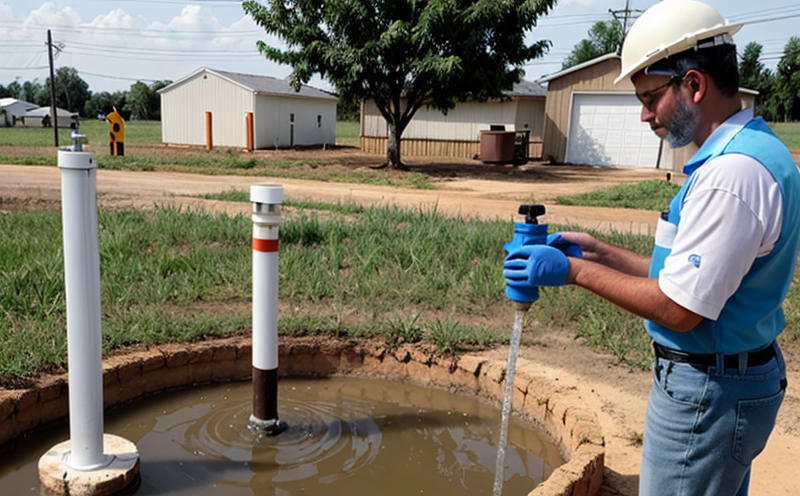ASTM D4750 Groundwater Level Measurement Testing
The ASTM D4750 standard provides a method for measuring groundwater levels using piezometers. This is crucial in various sectors such as environmental engineering, hydrology, and water resource management where the understanding of subsurface hydrology plays a vital role.
Groundwater level measurements are essential for assessing the health of aquifers, monitoring water table fluctuations, and managing water resources sustainably. The accuracy of these measurements can influence policy decisions on groundwater use, impact regulatory compliance, and inform the design of remediation strategies in contaminated sites.
The ASTM D4750 method involves installing piezometers at various depths within the aquifer to measure changes in groundwater levels over time. This information is critical for monitoring natural recharge processes, detecting contamination impacts on water tables, and evaluating the effectiveness of mitigation measures.
Compliance with this standard ensures that data collected adheres to international best practices, which can be essential for regulatory compliance and stakeholder confidence. The testing process involves precise instrumentation such as piezometers, dataloggers, and pressure transducers.
The primary goal of ASTM D4750 is to provide a standardized procedure for measuring groundwater levels at multiple depths simultaneously. This method allows for the collection of comprehensive data that can be used to model groundwater flow systems, assess water quality changes, and predict future trends in groundwater availability.
By following this standard, laboratories ensure consistency and reliability in their testing results, which is critical for accurate interpretation of environmental data. The standard also emphasizes the importance of proper installation and calibration of piezometers to minimize measurement errors.
The ASTM D4750 method has been widely adopted by regulatory agencies, consulting firms, and academic institutions worldwide due to its robustness and reliability. It is particularly valuable in areas where groundwater resources are under stress or where there is a risk of contamination from anthropogenic activities such as mining, agriculture, and industrial operations.
The standard also provides guidance on data interpretation and reporting, which helps ensure that stakeholders can make informed decisions based on the collected data. This includes recommendations for frequency of sampling, depth intervals, and methods for calculating drawdown or recovery rates in response to pumping activities.
Benefits
- Enhanced Accuracy: Ensures accurate measurement of groundwater levels through standardized procedures.
- Improved Compliance: Adherence to international standards for regulatory compliance and stakeholder confidence.
- Better Decision-Making: Provides comprehensive data that can be used to make informed decisions about water resource management.
- Precision Calibration: Ensures precise calibration of piezometers, minimizing measurement errors.
- Comprehensive Data Collection: Measures groundwater levels at multiple depths simultaneously for a more complete understanding of the aquifer system.
- Consistency in Results: Standardized procedures ensure consistent and reliable testing results.
- Sustainable Resource Management: Assists in the sustainable management of water resources by providing critical data on natural recharge processes and contamination impacts.
Customer Impact and Satisfaction
Our customers, primarily quality managers, compliance officers, and R&D engineers, benefit significantly from the ASTM D4750 Groundwater Level Measurement Testing service. By adhering to this standard, we provide them with accurate, reliable data that meets international best practices.
This ensures their stakeholders have confidence in the environmental management strategies they implement. The precise measurements and comprehensive data provided by our tests are crucial for regulatory compliance, which can prevent costly penalties and ensure long-term sustainability of water resources.
Our customers also appreciate the detailed reports we generate from these tests. These reports not only provide a clear picture of current groundwater conditions but also offer insights into trends over time. This information is invaluable for making informed decisions about future actions, whether it's increasing or decreasing pumping rates in aquifers, implementing new pollution control measures, or planning water resource development projects.
Moreover, our service enhances the reputation and credibility of our customers by demonstrating their commitment to sustainable water management practices. This can be a significant factor in securing funding for research and development initiatives or winning competitive bids for contracts related to environmental engineering and hydrology.
Competitive Advantage and Market Impact
The ASTM D4750 Groundwater Level Measurement Testing service provides our customers with a significant competitive advantage in several ways. Firstly, by adhering to this international standard, we ensure that the data collected is accurate, reliable, and consistent across different testing scenarios. This consistency allows for better decision-making and more robust planning of water resource management strategies.
Secondly, our service supports regulatory compliance, which can prevent costly penalties and ensure long-term sustainability of water resources. In today's highly regulated environment, this is a critical advantage that sets us apart from competitors who may not adhere to such standards.
Thirdly, the detailed reports we generate provide customers with valuable insights into current groundwater conditions and trends over time. This information is invaluable for making informed decisions about future actions. For instance, if an aquifer is showing signs of contamination, our data can help identify the source and extent of the problem, enabling prompt corrective action.
Our service also enhances the reputation and credibility of our customers by demonstrating their commitment to sustainable water management practices. This can be a significant factor in securing funding for research and development initiatives or winning competitive bids for contracts related to environmental engineering and hydrology.
In addition, the precise measurements and comprehensive data provided by our tests are essential for monitoring natural recharge processes and detecting contamination impacts on water tables. This information is critical for assessing the effectiveness of mitigation measures in contaminated sites and for predicting future trends in groundwater availability. Our customers can leverage this knowledge to stay ahead of competitors who may not have access to such detailed and reliable data.





